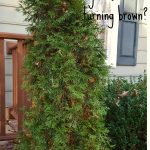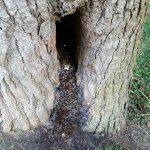What are the squiggly lines on my Aquilegia leaves? They are made from an insect larvae called a leaf miner. This larvae which can be from a sawfly, moth, or other insect is a general term for insect larvae that eats the tissue of leaves. Pesticides usually kill insects and not larvae so spraying is […]
Will my spring blooming tree bloom again in the spring if it bloomed in the fall?
Will my spring blooming tree bloom again in the spring if it bloomed in the fall? Short answer is yes. Nature is resilient and many times the weather plays tricks on the flowers, shrubs, and trees when the weather turns like spring with above average temps both during the day and at night. The dramatic […]
Why are the inner leaves of my Arborvitae turning brown?
Why are the inner leaves (foliage) of my Arborvitae turning brown? Simply put, and in my experience, it is just a shedding process that helps the plant shed its old leaves just as any deciduous tree loses its leaves in the fall. Unless the whole bush is turning brown, this inside browning and shedding is […]
What is this smelly tar like substance leaking from my Oak tree?
What is this smelly tar like substance leaking from my Oak tree? It is most likely ‘slime flux’ and it is a bacterial disease which in many cases does NOT cause long term or severe damage to the tree. Slime Flux Or Wetwood disease can affect Oaks, Tulip Populars, Elms, and Maples. There is nothing […]







